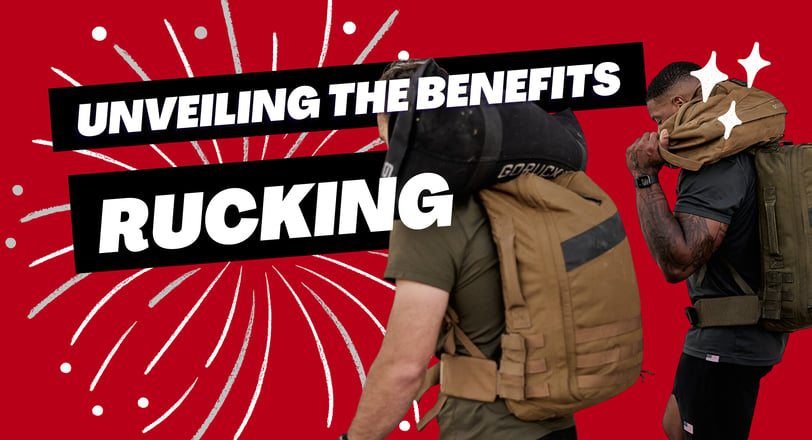Can Rucking Help You Lose Weight? A Deep Dive into Calories Burned and Fat Loss Benefits
7/2/20255 min read


What is Rucking and How Does it Work?
Rucking is a fitness activity that combines walking or hiking with the added challenge of carrying a weighted backpack. Originating from military training, rucking was initially used by soldiers to enhance endurance and strength while navigating various terrains. Over time, its practical benefits have gained popularity among fitness enthusiasts, resulting in a wider acceptance of rucking as an effective workout method for anyone aiming to improve their physical fitness.
The mechanics of rucking are relatively straightforward. Participants fill a backpack with weights, which can vary based on individual fitness levels and goals, and engage in a brisk walk or hike. The added weight increases the intensity of the workout, requiring more energy expenditure compared to walking without an added load. This enhancement of effort not only elevates the heart rate but also engages multiple muscle groups, thereby increasing calorie burn.
The appeal of rucking lies in its simplicity and versatility. It can be performed in various environments, including urban settings, parks, and hiking trails. This adaptability means individuals can tailor their rucking experience based on personal preferences and fitness levels. Additionally, variations of rucking, such as incorporating interval training or adjusting the weight and pace, can further amplify the workout’s effectiveness.
Factors that influence the effectiveness of rucking include the weight carried, the duration of the activity, and the terrain. Lighter weights may be suitable for beginners, while seasoned individuals may opt for heavier packs to experience greater benefits. Furthermore, incorporating inclines and varied surfaces can significantly enhance the workout's intensity, leading to greater calorie expenditure and fat loss over time. By leveraging these elements, rucking can be a highly beneficial addition to any weight loss regimen.
Calories Burned: Rucking vs. Other Workouts
Rucking, a form of exercise that involves walking or hiking with a weighted backpack, is gaining popularity due to its efficiency in burning calories and promoting weight loss. When examining the number of calories burned during rucking compared to other popular forms of exercise such as running, cycling, and traditional walking, it becomes evident that rucking can be a highly effective fat-burning workout.
Studies indicate that rucking can burn between 400 to 600 calories per hour, depending on various factors including the individual’s weight, walking speed, and the weight of the backpack. For example, a person weighing 160 pounds may burn approximately 450 calories per hour while rucking with a 20-pound load at a moderate pace. In contrast, running typically burns around 600 to 800 calories per hour depending on speed and distance. However, running requires a higher level of cardiovascular fitness, which may not be accessible to everyone, making rucking a more versatile option.
When comparing rucking to cycling, the calorie burn can vary significantly based on intensity and duration. A stationary cycling session may result in approximately 500 to 700 calories burned per hour, while outdoor cycling yields similar results depending on terrain and pace. Traditional walking, on the other hand, burns significantly fewer calories, averaging around 240 calories per hour for a person weighing 160 pounds. This disparity highlights rucking’s edge, as the addition of weight increases the energy expenditure dramatically.
It is important to note that individual metabolism plays a crucial role in overall calorie burn during any form of exercise. Factors such as age, body composition, and fitness level can influence how many calories are burned during rucking or any workout. Therefore, while rucking demonstrates formidable potential as a calorie-burning exercise, individual experiences may vary significantly, further emphasizing the importance of personalizing one’s fitness regimen for optimal weight loss results.
Benefits of Rucking for Weight Loss and Fitness
Rucking, the practice of walking with a weighted backpack, is rapidly gaining recognition as a viable exercise for weight loss and overall fitness improvement. This low-impact workout is accessible to various fitness levels and carries several unique benefits that can aid individuals on their weight loss journeys.
One significant advantage of rucking is its capacity to elevate cardiovascular health. By adding weight to a simple walking routine, participants increase the intensity of the workout, thereby boosting heart rate and calorie expenditure. Research suggests that engaging in moderate to vigorous physical activity, such as rucking, can enhance cardiovascular function, promote blood circulation, and lower the risk of chronic diseases. Consequently, this paves the way for improved weight management and reduced body fat percentage.
Moreover, rucking contributes to muscle strengthening and endurance building. When individuals carry weights during their walks, they activate various muscle groups, including the legs, core, and back. This not only facilitates muscle growth but also fosters greater endurance over time. As these muscles adapt and strengthen, individuals can engage in longer walks that further enhance calorie burn and promote fat loss.
Beyond the physical benefits, rucking serves as an excellent tool for mental health improvement. Walking outdoors while carrying a load can provide a meditative effect, helping to relieve stress and elevate mood. Exercise, in general, is known to trigger the release of endorphins—hormones associated with feelings of happiness. For those on a weight loss journey, this improved mental state can be invaluable, providing motivation and resilience during challenging moments.
Overall, rucking presents a multifaceted approach to weight loss by optimizing cardiovascular health, building muscle endurance, and enhancing mental well-being, making it an excellent addition to any fitness regimen.
Getting Started with Rucking: Tips and Tricks
For individuals interested in leveraging rucking as a form of exercise, starting correctly is crucial for both enjoyment and injury prevention. One of the first steps is selecting an appropriate backpack. It should be sturdy, comfortable, and designed to evenly distribute weight across your back. Look for backpacks that offer padded shoulder straps and a hip belt for added support during your rucking sessions.
When it comes to weight, beginners should start light to establish endurance and form. A good rule of thumb is to begin with approximately 10% of your body weight in your backpack. This allows for a comfortable yet effective rucking experience. As your strength and confidence increase, you can gradually add more weight to enhance the challenge and benefits. Always ensure that weights are secure to avoid shifting that can disrupt balance.
In terms of distance, novice ruckers should aim for a range of 1 to 3 miles during their initial outings. This distance is manageable while still providing significant cardiovascular benefits. Listen to your body; if you experience excessive fatigue or discomfort, it may be wise to shorten your distance or adjust your weight.
Maintaining proper form while rucking is pivotal to minimize the risk of injury. Keep your back straight and your core engaged, and maintain a steady pace. Feet should land directly beneath your body, and it can be beneficial to incorporate a heel-to-toe walking motion. This helps in maintaining momentum and reducing strain on the joints.
To integrate rucking into your existing workout routine, consider scheduling rucking sessions on days you would typically engage in moderate cardio. Doing so allows you to seamlessly blend this activity with other forms of exercise, amplifying your results and enhancing fat loss benefits. By following these tips, you can set a strong foundation for a successful rucking journey ahead.
